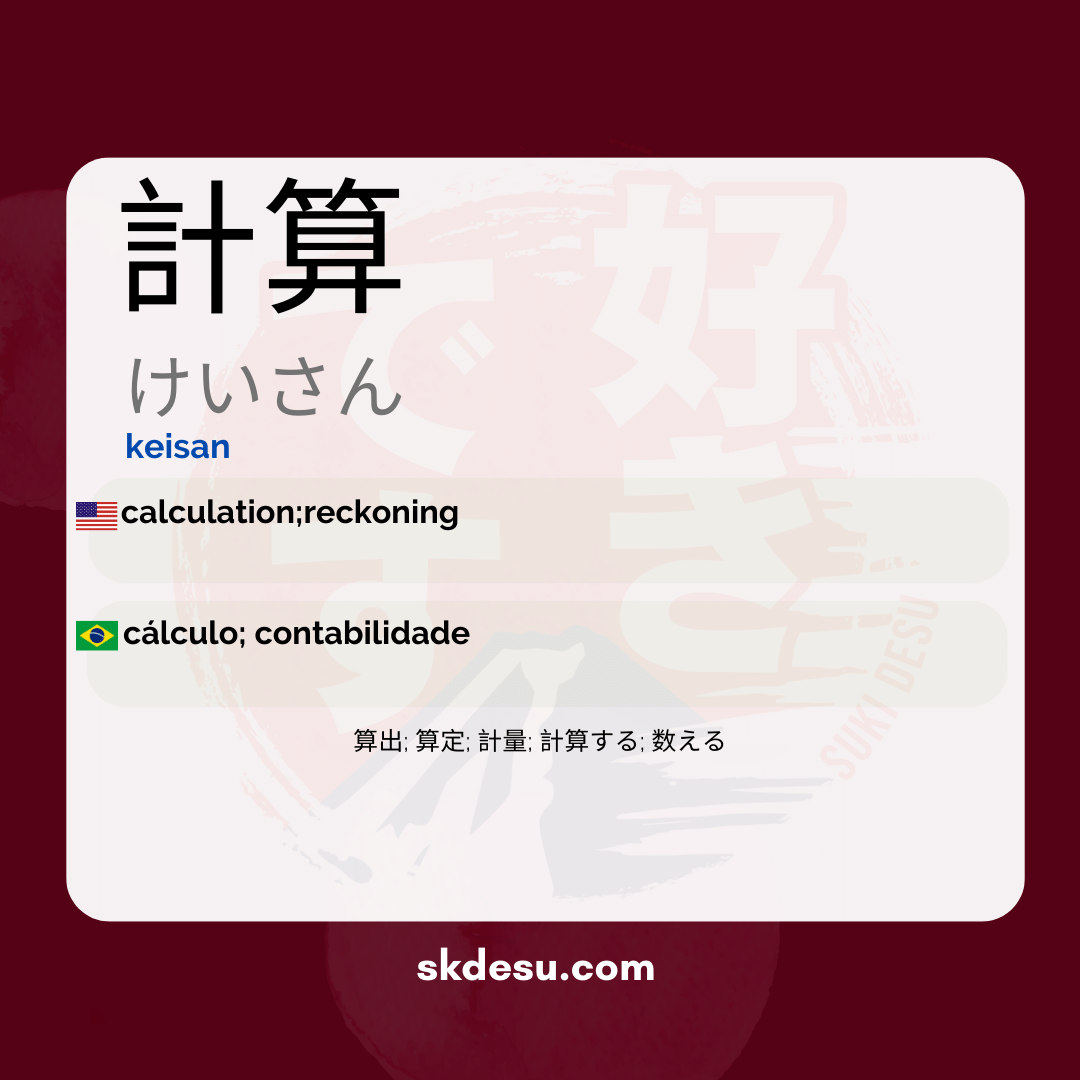Translation and Meaning of: 計算 - keisan
The Japanese word 計算[けいさん] is an essential term for those learning the language or interested in Japanese culture. Its meaning goes beyond simple translation, involving mathematical, everyday, and even philosophical contexts. In this article, we will explore what this word represents, how it is used in daily life, and some interesting facts that make its learning more engaging.
If you have ever wondered how the Japanese deal with accounts, planning, or even strategies, the answer may lie in 計算. Besides being a common word in textbooks, it frequently appears in animes, mangas, and informal conversations. Let's uncover its details so you can use it with confidence.
The meaning and use of 計算
Keisan [計算] is generally translated as "calculation" or "count," but its usage spans situations ranging from basic mathematics to more complex planning. In Japanese, it can be applied to both numerical operations and strategic forecasts, such as in "計算高い" (keisan takai), which describes someone calculating or acting with interest.
A common example is the phrase "計算してみて" (keisan shite mite), which means "try to calculate" or "do the math." This flexibility makes the word useful in different contexts, from a math class to a discussion about economics. Its kanji, 計 (measure) and 算 (calculate), reinforce this idea of measurement and analysis.
The origin and composition of kanji
The etymology of 計算 traces back to Chinese characters, where 計 (kei) means "to measure" or "to plan," while 算 (san) represents "calculation" or "counting." Together, they form a word that carries the notion of assessing quantities or devising strategies. This combination is not random—it reflects the importance that numerical precision has in Japanese culture.
It is worth noting that these kanjis appear in other related words, such as 会計 (kaikei, "accounting") and 予算 (yosan, "budget"). If you are learning Japanese, recognizing these radicals can help you memorize similar terms more easily. The logical structure behind these combinations is one of the reasons why Japanese is so fascinating for students.
Trivia and tips for memorization
An effective way to remember 計算 is to associate it with practical situations. For example, in many Japanese restaurants, the bill is called お計算 (o-keisan), demonstrating how the word is present even in simple everyday moments. Repeating this association mentally can help cement the term in memory.
Another interesting point is that, although 計算 (keisan) is neutral, its use can take on negative connotations depending on the context. Calling someone 計算高い (keisan takai) can be a compliment to their strategic intelligence, but it can also be a criticism if the person is seen as manipulative. This dual meaning makes learning the word even richer.
Vocabulary
Expand your vocabulary with related words:
Synonyms and similar words
- 算出 (sanshutsu) - Determination or calculation of results based on data.
- 算定 (santei) - Calculation or assessment based on forecasting; it may involve an estimate.
- 計量 (keiryō) - Measurement and quantification of things, especially in terms of weight or volume.
- 計算する (keisan suru) - Calculation of values or mathematical operations.
- 数える (kazoeru) - To count or enumerate; it refers to the counting of discrete items.
Related words
Romaji: keisan
Kana: けいさん
Type: noun
L: jlpt-n3
Translation / Meaning: calculation; accounting
Meaning in English: calculation;reckoning
Definition: Calculation of numbers and quantities.
Quick Access
- Vocabulary
- Writing
- Sentences
How to Write in Japanese - (計算) keisan
See below a step-by-step guide on how to write the word by hand in Japanese. (計算) keisan:
Example Sentences - (計算) keisan
See below some example sentences:
Soroban wo tsukatte keisan suru
Calculate using the abacus.
Calculate using a spatula.
- 算盤 (soroban) - a Japanese abacus used for mathematical calculations
- を (wo) - object particle
- 使って (tsukatte) - continuous form of the verb "tsukau", meaning "to use"
- 計算 (keisan) - Calculation
- する (suru) - verb that means "to do"
Warizan wa suugaku no kihonteki na keisan houhou desu
Division is a basic calculation method in mathematics.
Division is the basic calculation method in mathematics.
- 割り算 - It means "division" in Japanese.
- は - It is a TOPIC1TICLE particle indicating that "divisão" is the subject of the sentence.
- 数学 - It means "mathematics" in Japanese.
- の - It is a possessive particle indicating that "mathematics" is the owner of "division".
- 基本的な - It means "basic" or "fundamental" in Japanese.
- 計算方法 - means "calculation method" in Japanese.
- です - It is a closing partic1E31Cle that indicates that the sentence is complete and formal.
Bunsuu wo keisan suru no wa muzukashii desu
Calculating fractions is difficult.
It is difficult to calculate fractions.
- 分数 - means "fraction" in Japanese.
- を - object particle.
- 計算する - verb meaning "to calculate".
- のは - Particle that indicates the topic of the sentence.
- 難しい - adjective meaning "difficult".
- です - verb that indicates the polite form of "to be" or "to be" in Japanese.
Koushiki wo tsukatte keisan shimashou
Let's calculate using the official formula.
Let's calculate using the formula.
- 公式 (kōshiki) - formula
- を (wo) - object particle
- 使って (tsukatte) - using
- 計算 (keisan) - Calculation
- しましょう (shimashou) - let's do it
Ginmitsu na keisan ga hitsuyou desu
We need accurate calculations.
Rigorous calculations are required.
- 厳密な - rigorous, precise
- 計算 - Calculation
- が - subject particle
- 必要 - necessary
- です - Verb to be/estar in the present
Keisan ga kanryou shimashita
The calculation has been completed.
- 計算 - means "calculation" in Japanese
- が - particle that indicates the subject of the sentence
- 完了 - means "completed" or "finished" in Japanese
- しました - past form of the verb "suru", meaning "to do" or "to accomplish"
Other Words of this Type: noun
See other words from our dictionary that are also: noun

